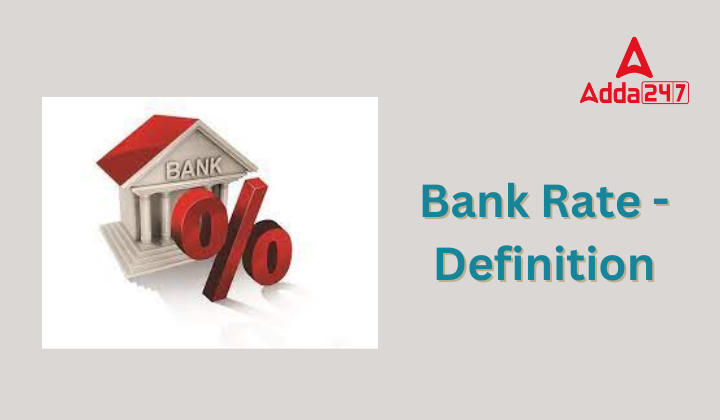Table of Contents
The bank rate represents the interest rate set by a central bank for lending loans to commercial banks. In times of fund shortage, commercial banks have the option to borrow money from their country’s central bank, such as the Reserve Bank of India in India’s case. This borrowing aligns with the monetary policy framework of the respective country.
What is Bank Rate?
- In India, the Bank Rate is a significant monetary policy instrument managed by the Reserve Bank of India (RBI), the country’s central bank. The Bank Rate refers to the interest rate at which the RBI provides loans and advances to commercial banks and financial institutions in the country.
- The Bank Rate plays a crucial role in influencing the overall interest rate structure in the Indian economy. When the RBI raises the Bank Rate, borrowing from the central bank becomes more expensive for commercial banks. As a result, commercial banks tend to increase the interest rates they charge on loans and advances to consumers and businesses. This increase in borrowing costs can lead to a slowdown in credit expansion and economic activity.
- Conversely, when the RBI lowers the Bank Rate, borrowing from the central bank becomes cheaper for commercial banks. This encourages banks to reduce the interest rates they charge on loans and advances, making borrowing more attractive for consumers and businesses. Lower interest rates can stimulate investment, consumption, and economic growth.
- The RBI uses the Bank Rate as part of its broader monetary policy framework to achieve various objectives, including controlling inflation, promoting economic growth, and maintaining financial stability. Changes in the Bank Rate are often accompanied by adjustments in other policy rates and measures, such as the Cash Reserve Ratio (CRR) and the Statutory Liquidity Ratio (SLR), to effectively manage liquidity conditions in the banking system.
- Overall, the Bank Rate in India serves as a key tool for the RBI to regulate credit availability, manage inflationary pressures, and support the country’s economic objectives while ensuring the stability of the financial system. It is closely monitored by financial institutions, businesses, and policymakers as an indicator of the prevailing monetary policy stance and its potential impact on the economy.
Bank Rate in India
The Bank Rate in India is a crucial concept in understanding the country’s monetary policy and its impact on the economy. It’s important to distinguish it from other key rates like the Repo Rate and Reverse Repo Rate:
- Bank Rate:
-Defined as the rate at which the Reserve Bank of India (RBI) provides loans to commercial banks without any collateral or security.
-Generally higher than the Repo Rate due to its unsecured nature.
-Currently stands at 5.15% as of January 29, 2024.
-Less frequently used than the Repo Rate as the RBI mainly uses the Repo Rate for liquidity management. - Repo Rate:
-The primary tool used by the RBI to control inflation and influence economic growth.
-Represents the rate at which commercial banks borrow from the RBI with government securities as collateral.
-Currently stands at 6.50% as of January 29, 2024.
-Changes in the Repo Rate directly impact lending rates across all sectors, influencing borrowing costs for individuals and businesses. - Reverse Repo Rate:
-The rate at which the RBI borrows from commercial banks.
-Currently stands at 3.35% as of January 29, 2024.
-Offers commercial banks a safe avenue to park their surplus funds. - Understanding the interplay:
-The Bank Rate serves as a benchmark for other lending rates in the banking system.
-While directly used less often, it can influence overall credit availability and cost.
-Changes in the Bank Rate often signal the RBI’s stance on monetary policy and future direction of Repo Rate adjustments. - Recent Trends:
-In June 2023, the RBI increased the Bank Rate to 6.75% along with the Repo Rate hike.
-However, in the latest policy meeting (January 2024), the Bank Rate was reduced to 5.15%, while the Repo Rate remained unchanged.
-This suggests a possible shift in the RBI’s strategy, focusing more on liquidity management through the Repo Rate while maintaining a flexible Bank Rate as a backup tool.




 TSPSC Group 1 Question Paper 2024, Downl...
TSPSC Group 1 Question Paper 2024, Downl...
 TSPSC Group 1 Answer key 2024 Out, Downl...
TSPSC Group 1 Answer key 2024 Out, Downl...
 UPSC Prelims 2024 Question Paper, Downlo...
UPSC Prelims 2024 Question Paper, Downlo...




